Good link, upvoted, thanks jawJ.A.W. wrote:If of interest, this site has a pictorial summary of Mopar concept cars..
http://www.allpar.com/model/concepts.html
Didn´t know there was a turbine car in the 60´s
http://www.allpar.com/mopar/turbine.html





Good link, upvoted, thanks jawJ.A.W. wrote:If of interest, this site has a pictorial summary of Mopar concept cars..
http://www.allpar.com/model/concepts.html





Showcasing is when the 'concept' has some sort of prototype of the technology. Your examples are only showcasing the ability of the PR person to use a keyboard.Andres125sx wrote:It showcase some new tech ...
Andres125sx wrote:Good link, upvoted, thanks jawJ.A.W. wrote:If of interest, this site has a pictorial summary of Mopar concept cars..
http://www.allpar.com/model/concepts.html
Didn´t know there was a turbine car in the 60´s
http://www.allpar.com/mopar/turbine.html
http://www.allpar.com/model/concepts/i/63turbinf.jpg
http://www.allpar.com/photos/vimages/be ... dlight.jpg
http://www.allpar.com/photos/vimages/be ... ine/74.jpg
http://www.allpar.com/photos/vimages/be ... ine/75.jpg
http://www.allpar.com/photos/vimages/be ... ne-bay.jpg
By 1953, the research team had produced the Firebird XP-21,[1] later referred to as the Firebird I, which was essentially a jet airplane on wheels. It was the first gas turbine powered car tested in the United States. The design is entirely impractical, with a bubble topped canopy over a single seat cockpit, a bullet shaped fuselage made entirely of fiberglass, short wings, and a vertical tail fin.[2] It has a 370 hp (280 kW) Whirlfire Turbo Power gas turbine engine, which has two speeds, and expels jet exhaust at some 1,250 °F (677 °C). The entire weight of the car is 2,500 lb (1,134 kg) and had a 100 inch wheelbase.[3]
At first, Conklin was the only person qualified to drive it, and he tested it up to 100 mph (160 km/h), but upon shifting into second gear the tires lost traction under the extreme engine torque and he immediately slowed down for fear of crashing. The car was later test driven at the Indianapolis Speedway by race car driver Mauri Rose. The car was never actually intended to test the power or speed potential of the gas turbine, but merely the practical feasibility of its use. The braking system differs from standard drum systems, in that the drums are on the outside of the wheels to facilitate fast cooling, and the wings actually have aircraft style flaps for slowing from high speed.


he second concept car, the Firebird II in 1956, was a more practical design: a four-seat, family car. It is a low and wide design with two large air intakes at the front, a high bubble canopy top, and a vertical tail fin. Its exterior bodywork was made entirely of titanium (which turned out to be hard to make).[4] The engine output was 200 hp (150 kW), and to solve the exhaust heat problem it was fed through a regenerative system,[4] which allowed the entire engine to operate at nearly 1,000 °F (538 °C) cooler, and also power the accessories. Kerosene was the most common fuel used.[4] Another innovation on the car was the first use of four wheel disc brakes, with a fully independent suspension, as well as a sophisticated guidance system which was intended to be used with "the highway of the future", where an electrical wire would be embedded into a roadway to send signals that would help guide future cars[5] and avoid accidents.
Specifications
GM internal code : XP-43
Wheelbase = 120 in (3,048 mm) [6]
Length = 234.7 in (5,961 mm) [6]
Ground clearance = 5.5 in (140 mm)



The third design, the Firebird III, was built in 1958 and first shown at Motorama in 1959. It is another extravagant concept with titanium skin, and no fewer than seven short wings and tail fins that were tested extensively in a wind tunnel. It is a two-seater powered by a 225 hp (168 kW) Whirlfire GT-305 gas turbine engine, and a two cylinder 10 hp (7.5 kW) gasoline engine to run all the accessories. Its exterior design features a double bubble canopy, and more technical advancements to make it more practical, such as cruise control, anti-lock brakes, and air conditioning. It also featured "space-age" innovations, such as special air drag brakes, like those found on aircraft, which emerged from flat panels in the bodywork of the car to slow it from high speeds, an "ultra-sonic" key which signaled the doors to open, and an automated guidance system to avoid accidents and "no hold" steering. The steering was controlled by a joystick positioned between the two seats.[7] This gave the car a more futuristic feel and simulated the experience of flying a plane.
Specifications
GM internal code : XP-73
Wheelbase = 119 in (3,023 mm) [8]
Length = 248.2 in (6,304 mm)
Height = 44.8 in (1,138 mm) (canopy top)[8]
Ground clearance = 5.3 in (135 mm)




The Firebird IV debuted at the 1964 New York World's Fair, in General Motors Futurama Exhibit. It was another sleek, aircraft-inspired, turbine-engined 'future' design, internally coded by GM as XP-790. It was conceived for a future where cars were guided automatically via programmed guidance systems, to "insure absolute safety at more than twice the speed possible on expressways of the day". [9] Though billed as being turbine-powered, the Firebird IV was in fact non-functional. The Firebird IV was repackaged for the 1969 show circuit as the Buick Century Cruiser. Reportedly, the show car was crushed in the 1980s.
Specifications: wheelbase : 119" overall length : 229.8" width : 77.6" height : 45"

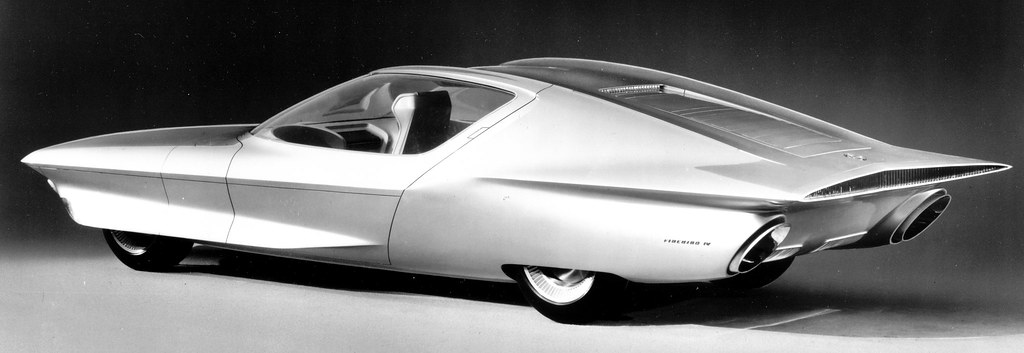


Nice! this was the next one on my list to post I just hadn't had the time to put it togetherbdr529 wrote:I think were forgetting one of the most influential concept cars, albeit for other reasons
1955 Lincoln Futura Show Car, that ended up becoming (few modifications) the original Batmobile in 1966.
but not before appearing in the 1959 Hollywood movie " It Started with a Kiss " (photo of Red car)
Staring Debbie Reynolds, the mother of Princes Leia (Carrie Fisher) and Sex kitten Eva Gabor
http://i65.photobucket.com/albums/h217/ ... viwtie.jpg
http://i65.photobucket.com/albums/h217/ ... yenpgb.jpg



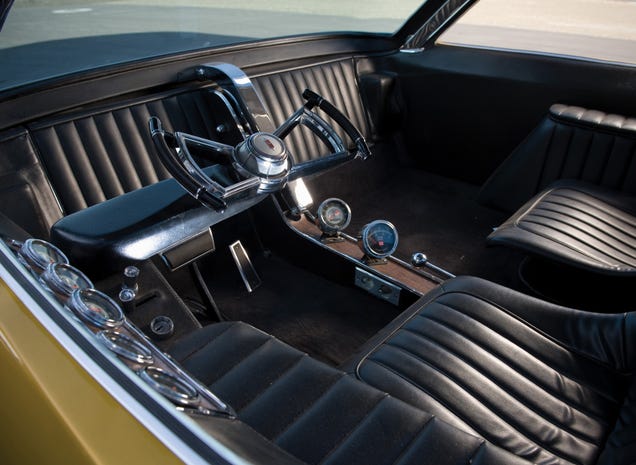
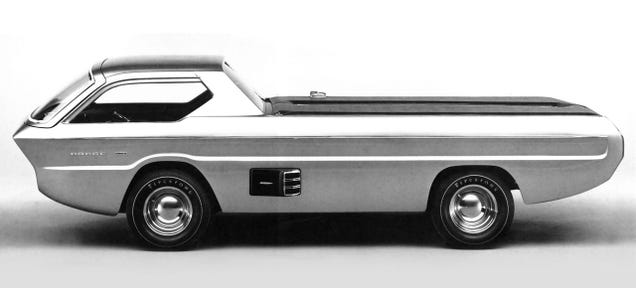
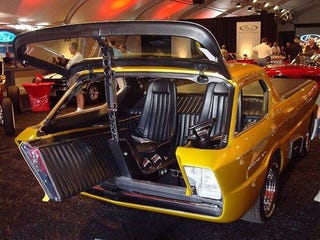
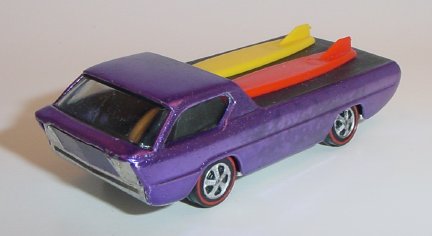
George Barris added custom tartan covered seats to the Spyder, He may have been the one to come up with "Little Bastard"flynfrog wrote: Nice! this was the next one on my list to post I just hadn't had the time to put it together
Trivia question What is the link of the Futura and The Little bastard
https://tejiendoelmundo.files.wordpress ... orsche.jpg
OMG what a weird thing!flynfrog wrote:I always liked the Dodge Deora. I never got the hotwheels though. Maybe I should search Ebay.
Take a close look at the interior ever wonder why the steering wheel has an oldsmobile emblem on it.
http://i.kinja-img.com/gawker-media/ima ... fgodaz.jpg
http://i.kinja-img.com/gawker-media/ima ... hhbhtb.jpg
http://i.kinja-img.com/gawker-media/ima ... 9eopso.jpg
http://i.kinja-img.com/gawker-media/ima ... swcrfs.jpg
http://i.kinja-img.com/gawker-media/ima ... h2v1hb.jpg
http://onlineredlineguide.com/68/68_deo ... Purple.jpg
I was curious, as I had this hot wheels car as a kid, I went to the red line guide, just to check it out,flynfrog wrote:I always liked the Dodge Deora. I never got the hotwheels though. Maybe I should search Ebay.
http://onlineredlineguide.com/68/68_deo ... Purple.jpg